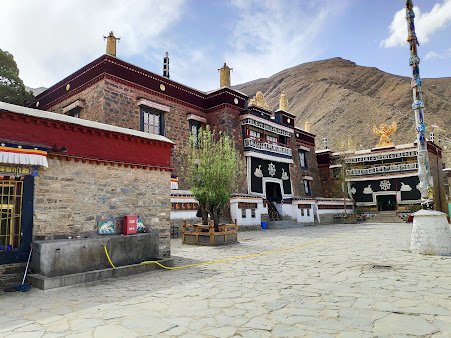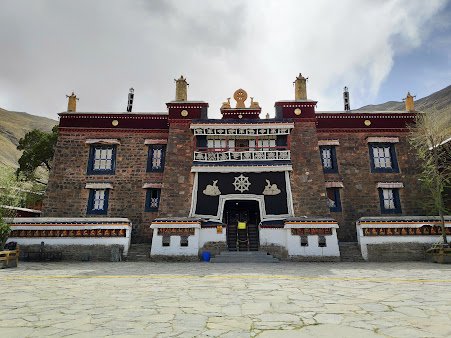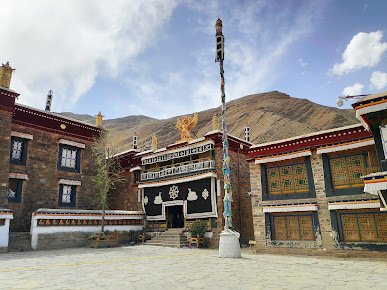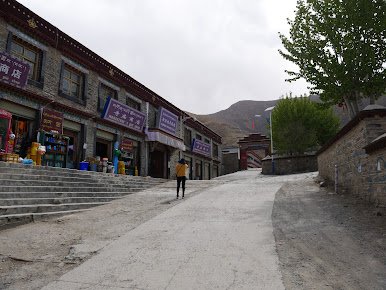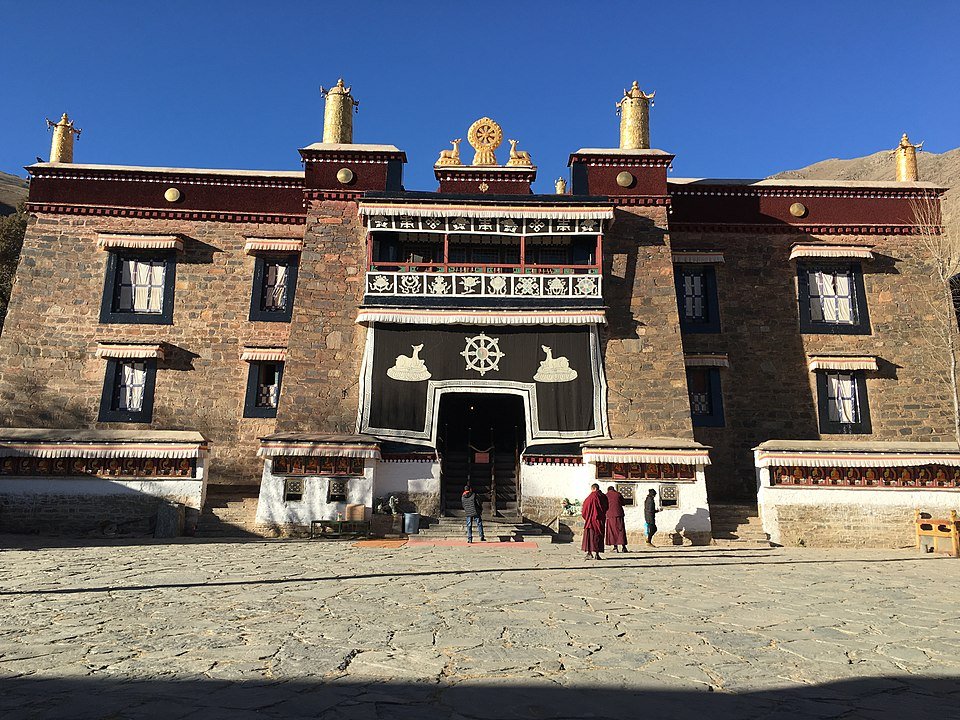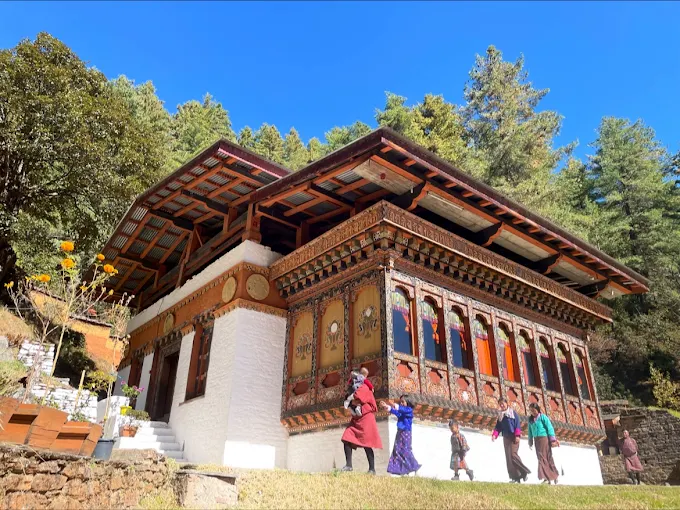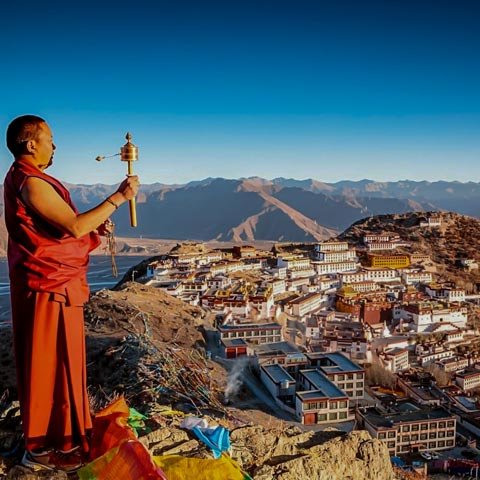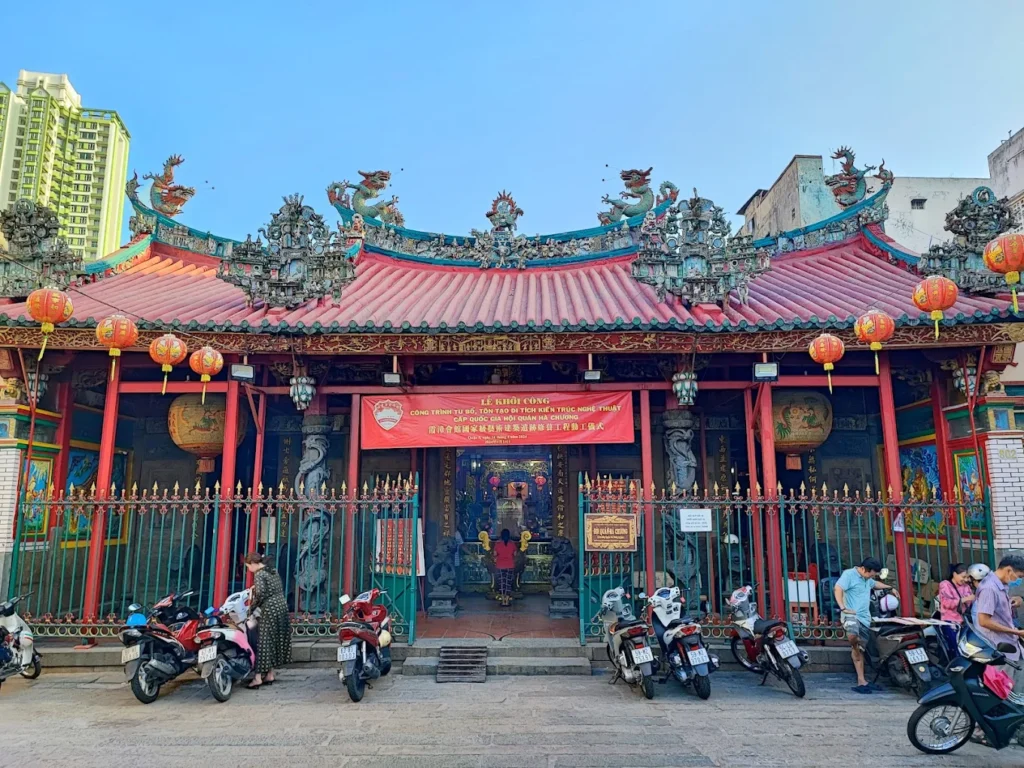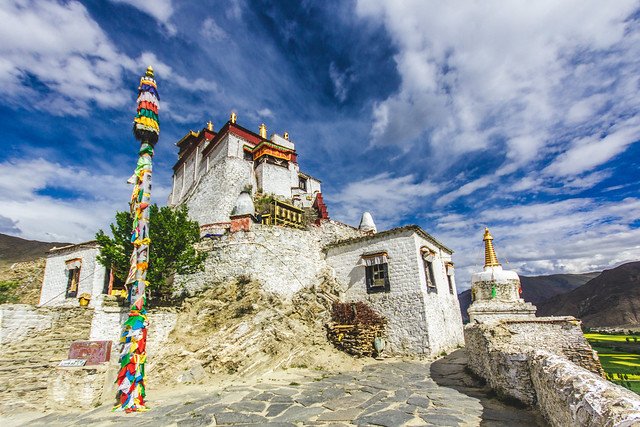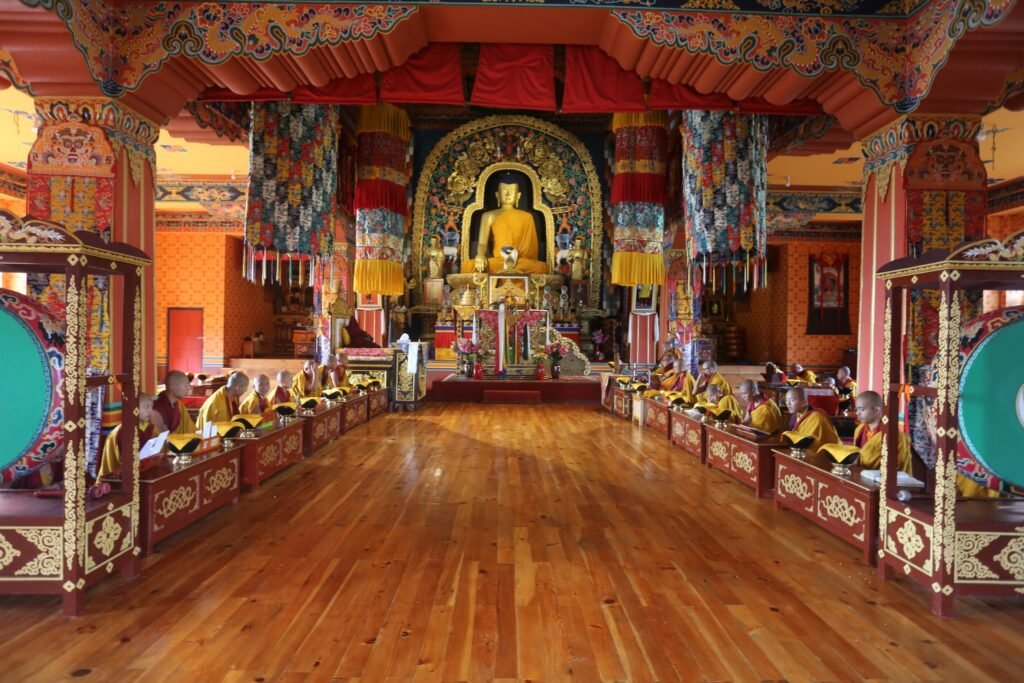Mindrolling Monastery: The Great Stupa’s Nyingma Legacy
Mindrolling Monastery, nestled along the southern banks of the Yarlung Tsangpo River near Tsedang, Tibet, stands as a radiant pillar of the Nyingma sect, its Great Stupa of Dharmakaya symbolizing enlightenment’s eternal truth. Founded in 1676 by Terdak Lingpa, this sacred sanctuary, known as the “Garden of Consciousness,” became a beacon of Nyingma scholarship and ritual mastery. At 3,500 meters, its golden spires and whitewashed walls gleam against the Yarlung Valley’s lush fields, captivating pilgrims and travelers with its spiritual depth. This immersive listing unveils Mindrolling’s essence, guiding you through its storied past, architectural splendor, sacred rituals, and practical visitor insights, offering a journey into a cornerstone of Tibetan Buddhism.
The Enlightened Heart of Mindrolling
Essence of Mindrolling Monastery
Mindrolling Monastery pulses with the profound wisdom of the Nyingma sect, embodying Tibet’s oldest Buddhist tradition through its emphasis on Dzogchen teachings. Established in 1676 by Terdak Lingpa, it became a scholarly and ritual hub, preserving Nyingma texts and practices. Its defining treasure—the Great Stupa of Dharmakaya, built in 2002—radiates as a global symbol of peace and enlightenment. Tucked in the Yarlung Valley, Mindrolling’s serene ambiance invites contemplation of Tibet’s spiritual heritage.
- Spiritual Core: Major Nyingma sect center, Dzogchen focus.
- Iconic Feature: Great Stupa of Dharmakaya, peace symbol.
- Cultural Role: Hub of Nyingma scholarship and ritual.
Historical Evolution
Mindrolling’s story began in 1676 when Terdak Lingpa, a visionary tertön (treasure revealer), founded the monastery under King Lhagyari’s patronage, naming it “Orgyen Mindrolling” (Garden of Consciousness). By the 18th century, it flourished as a translation and ritual center, with Terdak’s daughter, Jetsun Migyur Paldron, rebuilding it after invasions. The Cultural Revolution (1966–1976) razed its original structures, but restoration since 1985, led by the 11th Mindrolling Trichen, revived its halls. The Great Stupa’s 2002 consecration marked a modern milestone, drawing global pilgrims.
- Founding: Built in 1676 by Terdak Lingpa.
- Rebuilding: Restored by Jetsun Migyur Paldron, 18th century.
- Restoration: Revived since 1985, Stupa built in 2002.
Cultural Impact
Mindrolling’s scholarly legacy, through Terdak Lingpa’s terma texts and ritual compilations, shaped Nyingma practices across Tibet. Its translation center produced key Dzogchen texts, preserved in archives like HimalayanArt.org. Annual festivals, like the Drubchen ceremony, maintain Nyingma traditions, drawing Yarlung Valley pilgrims. Globally, Mindrolling’s influence extends via its Indian branch (est. 1965) and teachings by masters like Dzongsar Khyentse Rinpoche, with works like Dudjom Rinpoche’s The Nyingma School highlighting its role.
- Scholarly Legacy: Dzogchen texts, ritual compilations.
- Festival Traditions: Drubchen preserves Nyingma rites.
- Global Reach: Indian branch, global Nyingma networks.
Signature Legacy
The Great Stupa of Dharmakaya, standing 185 feet tall, is Mindrolling’s crowning jewel, its golden spire and 50-ton Buddha statue radiating peace since its 2002 consecration. A sacred Guru Rinpoche statue in the Tsuglhakhang, revealed by Terdak Lingpa, anchors the monastery’s spiritual identity. A legend tells of a rainbow appearing during the Stupa’s consecration, signaling divine blessings. These relics and the Stupa’s global pilgrimage status define Mindrolling’s enduring allure.
- Great Stupa: 185-foot peace monument, 2002.
- Guru Rinpoche Statue: Terdak Lingpa’s terma relic.
- Rainbow Legend: Divine consecration sign.
Community and Global Reach
Yarlung Valley locals revere Mindrolling, offering butter lamps during festivals and life events. Its 80 monks, primarily Nyingma, maintain rituals and guide pilgrims, fostering spiritual continuity. The Tibetan diaspora connects via the Indian Mindrolling in Dehradun, while international tourists, drawn by Tibet Travel and Mindrolling.org, explore its halls. Social media posts on X and academic studies amplify its influence, linking it to global Buddhist communities.
- Local Devotion: Butter lamp offerings by Yarlung residents.
- Monastic Community: 80 Nyingma monks guide pilgrims.
- Global Appeal: Indian branch, tourists, scholars.
Architectural Splendor of Mindrolling
Distinctive Design
Mindrolling’s architecture, spanning 10,000 square meters at 3,500 meters, blends traditional Tibetan and modern elements, its whitewashed walls and golden spires glowing in the Yarlung Valley. Centered on the Tsuglhakhang (main hall) and Great Stupa, it features a courtyard with chortens and prayer wheels, reflecting 17th-century Nyingma styles. The Stupa’s modern design, with Indian and Western influences, contrasts with Tibetan mud-brick halls, creating a harmonious aesthetic. This fusion makes Mindrolling a visual testament to Nyingma’s evolution.
- Style: Tibetan-modern architectural blend.
- Layout: Tsuglhakhang, Great Stupa, chortens.
- Setting: White walls in Yarlung Valley.
Signature Structures
The Great Stupa of Dharmakaya, built in 2002, dominates Mindrolling, its 185-foot height and 50-ton Buddha statue radiating serenity, with inner relics blessing pilgrims. The Tsuglhakhang, restored in 1985, houses the Guru Rinpoche statue and thangkas of Nyingma deities. The Zangdok Palri temple, depicting Guru Rinpoche’s celestial realm, glows with murals, while the outer kora path, lined with 108 prayer wheels, invites devotion. These structures embody Mindrolling’s spiritual grandeur.
- Great Stupa: 185-foot monument, 50-ton Buddha.
- Tsuglhakhang: Guru Rinpoche statue, thangkas.
- Zangdok Palri: Celestial realm murals.
Artisanal Mastery
Mindrolling’s thangkas, crafted by monks, depict Nyingma deities like Chenresig with mineral pigments, their hues vibrant after restoration. The Great Stupa’s Buddha statue, cast in bronze and gilded, showcases modern sculptural finesse, while Tsuglhakhang’s clay statues reflect 17th-century techniques. Carved wooden beams, featuring lotus motifs, adorn halls, and silk thangkas of Terdak Lingpa hang in chapels. These works, preserved through 1985 restoration, highlight Mindrolling’s artistic legacy.
- Thangkas: Nyingma deities, vibrant pigments.
- Buddha Statue: Gilded bronze, modern craftsmanship.
- Wood Carvings: Lotus-motif beams, silk thangkas.
Hidden Architectural Gems
Mindrolling conceals subtle treasures within its sacred spaces. The Stupa’s inner chamber, rarely open, holds relics like Terdak Lingpa’s terma texts, inviting reverence. A faded mural in the Zangdok Palri temple depicts the 1676 founding, a historical glimpse. The courtyard’s mani stone wall, etched with Om Mani Padme Hum, offers quiet reflection, while a small shrine near the kora hides a self-arising mani stone, believed to bless pilgrims.
- Inner Chamber: Stupa relics, Terdak Lingpa texts.
- Founding Mural: 1676 artwork in Zangdok Palri.
- Mani Stone Wall: Mantra-etched courtyard stones.
Preservation and Evolution
Preserving Mindrolling’s structures is a delicate task against Tibet’s climate. Restoration since 1985, funded by state grants and global devotees, used traditional pigments for thangkas and reinforced mud-brick walls. The Great Stupa’s 2002 construction, designed by Western architects, blends modern durability with Nyingma aesthetics. Ongoing efforts, supported by Mindrolling.org donations, ensure the monastery’s legacy endures, despite erosion and seismic risks.
- Restoration: Pigments, wall reinforcements since 1985.
- Stupa Construction: Modern design, 2002.
- Funding: State, global devotees.
Sacred Rites and Nyingma Devotion
Sacred Daily Rites
Each dawn, Mindrolling stirs with resonant chants, as monks gather in the Tsuglhakhang, their voices blending with butter lamp smoke. Pilgrims offer khatas (silk scarves) at the Guru Rinpoche statue, their prayers mingling with juniper incense. The hum of 108 prayer wheels along the kora path creates a meditative rhythm, enveloping visitors in Mindrolling’s spiritual calm.
- Chanting: Morning sutras in Tsuglhakhang.
- Offerings: Khatas at Guru Rinpoche statue.
- Ambiance: Incense, prayer wheel hum.
Unique Spiritual Practices
Mindrolling’s monks perform Nyingma rituals, including Dzogchen meditations and vajra empowerments, reflecting the sect’s esoteric roots. Pilgrims walk the kora around the Great Stupa, spinning prayer wheels to accrue merit, a practice tied to its enlightenment symbolism. The Zangdok Palri temple hosts Guru Rinpoche-focused blessings, unique to Mindrolling’s terma tradition. These rituals, steeped in Terdak Lingpa’s teachings, deepen the monastery’s spiritual allure.
- Dzogchen Meditations: Nyingma esoteric practices.
- Stupa Kora: 108 prayer wheel circumambulation.
- Guru Rinpoche Blessings: Terma-focused rites.
Vibrant Festival Traditions
Mindrolling’s festivals transform the monastery into a vibrant devotional hub. The Drubchen ceremony, held in the tenth lunar month, features 10-day tantric rituals and Cham dances depicting Nyingma deities, drawing pilgrims. Saka Dawa, marking Buddha’s enlightenment, includes kora walks, lamp offerings, and mass prayers. Sharing tsampa (roasted barley) and butter tea unites locals, echoing Mindrolling’s role as a community anchor.
- Drubchen Ceremony: 10-day tantric rites, Cham dances.
- Saka Dawa: Kora, lamp offerings, prayers.
- Community Role: Tsampa, tea shared.
Visitor Engagement
Visitors can offer khatas or light butter lamps at the Guru Rinpoche statue, guided by monks, immersing in Mindrolling’s spiritual life. Photography is permitted in most areas for a 10-yuan fee, capturing thangkas’ vivid details, but flash is prohibited, and the Stupa’s inner chamber bans photos. Joining the kora around the Stupa lets travelers walk with pilgrims, feeling Mindrolling’s sacred rhythm. Monks may share tales of Terdak Lingpa’s terma revelations, enriching the visit.
- Offerings: Khatas, lamps with monk guidance.
- Photography: 10-yuan fee, no flash, no Stupa chamber photos.
- Kora Participation: Walk with pilgrims.
Monastic and Community Roles
Mindrolling’s 80 monks, primarily Nyingma, maintain daily rites, study Dzogchen texts, and guide visitors, upholding its scholarly legacy. They offer blessings for local harvests, weddings, and life events, strengthening Yarlung Valley ties. The monastery trains young monks in thangka painting and ritual dance, preserving Nyingma artistry. This bond ensures Mindrolling remains a living spiritual center, fostering devotion and continuity.
- Monastic Duties: Rites, study, visitor guidance.
- Community Ties: Blessings for local events.
- Art Preservation: Thangka, dance training.
Visiting Mindrolling Monastery
Navigating to Mindrolling Monastery
Mindrolling lies 8 km south of Tsedang in Shannan Prefecture, 135 km southeast of Lhasa, along the Yarlung Tsangpo River’s southern bank. From Lhasa, a 135-km drive via the G318 highway takes 2.5 hours by bus or private tour vehicle, passing Tsedang. From Tsedang, a 15-minute taxi or 25-minute walk along the Tsedang-Zhanang road reaches the monastery, marked by the Great Stupa’s golden spire. The nearby Tradruk Monastery, 7 km away, serves as a guiding landmark.
- From Lhasa: 2.5-hour drive, 135 km via Tsedang.
- From Tsedang: 15-minute taxi, 8 km south.
- Local Access: Walk or taxi from Tsedang, near Tradruk.
Address of Mindrolling Monastery
- Location: Zhanang County, Shannan Prefecture, Tibet Autonomous Region, China.
- Coordinates: 29.1833° N, 91.7333° E.
- Context: Yarlung Tsangpo Valley, 8 km south of Tsedang.
Visiting Hours and Etiquette
Mindrolling is open daily from 9:00 AM to 6:00 PM, with early visits offering quieter exploration and cooler temperatures. Dress modestly, covering shoulders and knees, and remove hats in chapels to show respect. Photography is allowed in most areas for a 10-yuan fee; bring a flashlight for dim interiors, avoid flash, and note the Stupa’s inner chamber prohibits photos. Respect pilgrims by maintaining silence and not touching relics or statues.
- Hours: 9:00 AM–6:00 PM, best in morning.
- Dress Code: Modest clothing, no hats in chapels.
- Etiquette: 10-yuan photo fee, no flash, no Stupa chamber photos.
Accessibility and Safety
Mindrolling’s main areas are accessible via flat, paved paths, but the Stupa’s upper levels and some chapels involve steps, challenging for those with mobility issues. Wheelchair users require assistance due to uneven terrain; arrange with tour operators. Mindrolling’s 3,500-meter altitude, lower than Lhasa, still requires acclimatization; hydrate and rest to avoid sickness. The rural setting is safe, but watch for stray dogs and carry cash for fees.
- Accessibility: Paved paths, steps in Stupa, chapels.
- Mobility Aids: Limited, arrange assistance.
- Safety: Acclimatize, watch for dogs, carry cash.
Amenities and Surroundings
Mindrolling offers basic amenities, including restrooms and a small shop selling khatas and prayer beads. Tsedang’s markets, 8 km away, serve momos (dumplings), butter tea, and yak-meat noodles, immersing visitors in local flavors. The monastery’s courtyard, with prayer flags and chortens, provides serene reflection spots. The Yarlung Valley’s fields and nearby Tradruk Monastery offer scenic exploration, enriching the visit.
- Amenities: Restrooms, small shop.
- Food: Tsedang markets with momos, tea.
- Surroundings: Courtyard, Yarlung Valley, Tradruk.
Immersive Visitor Tips
Arrive at dawn to hear monks chanting in the Tsuglhakhang, their voices echoing through the hall, setting a meditative tone. Photograph the Great Stupa from the courtyard at midday, capturing its golden spire against the sky, paying the 10-yuan fee and avoiding flash. Walk the kora around the Stupa at dusk, when the valley glows golden, enhancing Mindrolling’s spiritual ambiance. Savor butter tea in Tsedang’s markets, chatting with locals about Terdak Lingpa’s terma for cultural depth.
- Dawn Visits: Hear chants in Tsuglhakhang.
- Photography: Stupa courtyard shots, 10-yuan fee, no flash.
- Evening Kora: Valley views at dusk.
